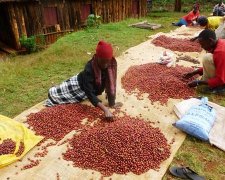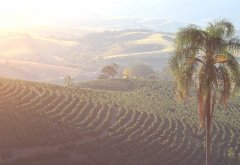How to brew Indian monsoon malaba coffee? History of different regions of India Coffee bean flavor differences
Coffee in Malaba, southern India, is treated with wind stains in the sun, which will be introduced in the following knowledge popularization. This coffee has a low acidity and a very special taste. Next, I would like to show you how to make this type of coffee.
Recommended cooking method: hand flushing
Filter cup: KONO filter cup
Water temperature: 87-88C
Amount of powder: 15g
Powder / water ratio: 1:15
Degree of grinding: medium grinding (pass rate of standard sieve No. 20 78%) flushing and cooking method: segmented extraction
Steam with 30 grams of water, the steaming time is about 30 seconds, the small flow center is injected with 95 grams of water around the circle, that is, 125 grams of water is divided into sections, and so the water level drop is about to expose the powder bed, continue to inject water to the end of 225 grams, remove the filter cup when the water level drop is about to expose the powder bed, and (the time of steaming starts) the extraction time is 2 grams 39 percent 00 ".

Tamil Nadu (Tamil Nadu): the region's wildlife reserve is home to spotted leopards, while plantations are home to high-quality, high-growing Arabica coffee, including exotic Kent.
Altitude: 1000-1400 m MSL
Rainfall: 2500-3000 mm
Main types of coffee: Arabica coffee
Total area: 2500 ha
Average output: 1500 tonnes
Main varieties: S.795, Cauvery, Sln.9
Araku valley (Andhra Pradesh): home to colorful parrots, a flock of chirping red and green birds are often seen running through the woods in this scenic valley.
Altitude: 9-1100 m MSL
Rainfall: 1000-1200 mm
Main type of coffee: Arabica coffee
Total area: 20000 ha
Average output: 3100 tons
Main varieties: S.795, Sln.4, Sln.5, Cauvery
Main intercropping: pepper, mango, jackfruit, vegetables
Bababudangiris (Karnataka): Bababudan brought seven kinds of "magic" beans from Yemen and planted them in the high mountains of the region. Deer are often found here, grazing next to plantations with rich Arabica coffee.
Altitude: 1500-2000 m MSL
Rainfall: 1100-1200 mm
Main type of coffee: Arabica coffee
Total area: 800 ha
Average output: 700-800 metric tons
Main varieties: S.795, Sln.9, Cauvery
Main intercropping: orange, banana, pepper
Biligiris (Karnatka/Tamil Nadu): in addition to the rich Arabica coffee, the region is also famous for its water deer, which is the largest Indian deer with huge antlers.
Altitude: 1500-2000 m MSL
Rainfall: 1100-1200 mm
Main type of coffee: Arabica coffee
Total area: 800 ha
Average output: 700-800 metric tons
Main varieties: S.795, Sln.9, Cauvery
Main intercropping: orange, banana, pepper
Brahmaputra River Brahmaputra: the powerful Brahmaputra River, which flows through the northeastern states, is the lifeline of the region, home to unicorn rhinos. This strong animal is widely found in Kaziranga National Park in eastern Assam.
Altitude: 800-1200 m MSL
Rainfall: 1500-2000 mm
Main type of coffee: Arabica coffee
Total area: 5000 ha
Average output: 300 tonnes
Main varieties: S.795, Cauvery
Main intercropping: pineapple, pepper, jackfruit, vegetables
Chikmagalur: Chikmagalur's forest and wildlife reserve is rich in India's national bird, the beautiful peacock. The peacock likes to show off its colorful feathers, especially in its elaborate courtship dance.
Altitude: 700-1200 m MSL
Rainfall: 1000-4500 mm
Main types of coffee: Arabica, Robusta
Total area of coffee: Arabica-37000 hectares, Robusta-23000 hectares
Average output: Arabica-29000 tons, Robusta-30
Main Arab varieties:-S.795, Sln.5B,Sln.9, Cauvery
Robusta-Peridenia, S.274, CxR
Main intercropping: pepper, cardamom, betel nut, orange, vanilla
Coorg (Karnataka): the lush coffee plantations are full of bees, which produce delicious Coorg honey collected by agile tribes.
Altitude: 750m-1100 m MSL
Rainfall: 1000-2500 mm
Main types of coffee: Arabica, Robusta
Total area of coffee: Arabica-26000 hectares, Robusta-56000 hectares
Average output: Arabica-24000 tons, Robusta-69
Species Maina-S.795, Sln.6, Sln.9; Coveri; Robusta-S.274 CXR
Main intercropping: pepper, cardamom, orange, banana, betel nut
Mangarabad Manjarabad (Karnataka): gentle slopes, streams and coffee trees provide a natural habitat for jungle poultry. The yellow-headed bird, with red combs and multicoloured feathers, usually appears in pairs, near coffee plantations.
Altitude: 9-1100 m MSL
Rainfall: 1000-2500 mm
Main types of coffee: Arabica, Robusta
Average output: Arabica-21000 tons, Robusta-9400 tons
Arabica Coffee varieties-S.795, Sln.6,Sln.9, Cauvery Robusta-S.274, CxR
Main intercropping: pepper, cardamom, orange, betel nut, banana
Neil Gilles Nilgiris (Tamil Nadu): the area's wildlife reserve is home to leopards, while plantations are home to high-quality, high-growing Arabica coffee, including exotic Kent.
Altitude:
9-1400 m MSL rainfall: 1600-2600 mm
Main types of coffee: Arabica, Robusta
Total area of coffee: Arabica-3600 hectares, Robusta-4000 hectares
Average output: Arabica-1400 tons, Robusta-2800 tons
Main varieties: Arabica coffee-S.795, Kents, Cauvery Robusta-Peridenia, S.274, CxR
Main intercropping: pepper, orange, banana, ginger, vegetable
Pulneys (Tamil Nadu): a famous feature of the region is the bright hyacinth-like Kurinji flowers that appear every 12 years. However, the high-growth Arabica coffee dominates year after year.
Altitude: 600-2000 m MSL
Rainfall: 1000-1600 mm
Main types of coffee: Arabica coffee
Total area: 14000 ha
Average output: 7500 tonnes
Main varieties: S.795, Sln.5B, Sln.9, Sln.10, Cauvery
Main intercropping: oranges, bananas, pepper, cardamom, vegetables
Sheveroys (Tamil Nadu): the magnificent Gaur or Indian bison is a sign of energy and strength, like the bold Arabica coffee grown here. This huge animal has a huge head and strong limbs and grazes in the low mountains of this picturesque area.
Altitude: 9-1500 m MSL
Rainfall: 800mm-1500 mm
Main type of coffee: Arabica coffee
Total area: 5000 ha
Average output: 3000 tonnes
Main varieties: S.795, Cauvery, Sln.9
Main intercropping: orange, banana, pepper

Travancore (Kerala): the national flower of India, the lotus symbolizes purity and beauty. These bright, fragrant flowers with floating leaves and long stems grow in the shallow waters of the region famous for Arabica and Robusta coffee.
Altitude: 400-1600 m MSL
Rainfall: 2000-4000 mm
Main types of coffee: Robusta coffee
Total area: 13000 ha
Average output: 9000 tonnes
Main varieties: S.274CxR
Main intercropping: pepper, banana, ginger, medicinal plants
Wayanad (Kerala): Wayanad is the home of the Indian tiger, the national treasure of India. It is a symbol of bravery and courage.
These wonderful and exotic coffees are made from washed Arabica coffee grown in Chikmagalur, Coorg, Biligiris, Bababudangiris and Shevaroys. The beans are very large, evenly turquoise and clean and polished. In the cup, the coffee shows a strong aroma, medium to good body, good acidity and good flavor, with a hint of spice. This is a rare high-quality coffee that really represents the best coffee in India.
Altitude: 600m-900m MSL
Rainfall: 1100-1200 mm
Main types of coffee: Robusta coffee
Total area: 67000 ha
Average output: 54000 tonnes
Main varieties: Peridenia, S.274, CxR
Main intercropping: pepper, banana, ginger
Important Notice :
前街咖啡 FrontStreet Coffee has moved to new addredd:
FrontStreet Coffee Address: 315,Donghua East Road,GuangZhou
Tel:020 38364473
- Prev

Characteristics of planting and processing Flavor of washed Coffee in Kenya brief introduction of Coffee washing and processing Plant gikirima
Africa used to dominate the global coffee market. At the peak of production, African countries accounted for four of the world's top ten coffee producers. Today, African coffee beans still compete in the world coffee market. Kenya is one of the largest exporters of fine coffee on the African continent. Qianjie will take you to learn about the cultivation and processing of coffee in Kenya. The GIKIRIMA factory is located in Mount Kenya.
- Next

The reason why Brazil is rich in coffee beans high-quality coffee flavor characteristics Brazil coffee bean output first in the world
Some of the most popular coffee in the world originated in South America, and perhaps no country in the region does better than Brazil. Brazil has been the largest participant in the international coffee trade since the 1840s. Today, the country produces 40 to 60 million bags of coffee a year and is the world's largest exporter of instant coffee. The coffee grown in Brazil is mainly Arabica coffee.
Related
- Detailed explanation of Jadeite planting Land in Panamanian Jadeite Manor introduction to the grading system of Jadeite competitive bidding, Red bid, Green bid and Rose Summer
- Story of Coffee planting in Brenka region of Costa Rica Stonehenge Manor anaerobic heavy honey treatment of flavor mouth
- What's on the barrel of Blue Mountain Coffee beans?
- Can American coffee also pull flowers? How to use hot American style to pull out a good-looking pattern?
- Can you make a cold extract with coffee beans? What is the right proportion for cold-extracted coffee formula?
- Indonesian PWN Gold Mandrine Coffee Origin Features Flavor How to Chong? Mandolin coffee is American.
- A brief introduction to the flavor characteristics of Brazilian yellow bourbon coffee beans
- What is the effect of different water quality on the flavor of cold-extracted coffee? What kind of water is best for brewing coffee?
- Why do you think of Rose Summer whenever you mention Panamanian coffee?
- Introduction to the characteristics of authentic blue mountain coffee bean producing areas? What is the CIB Coffee Authority in Jamaica?

